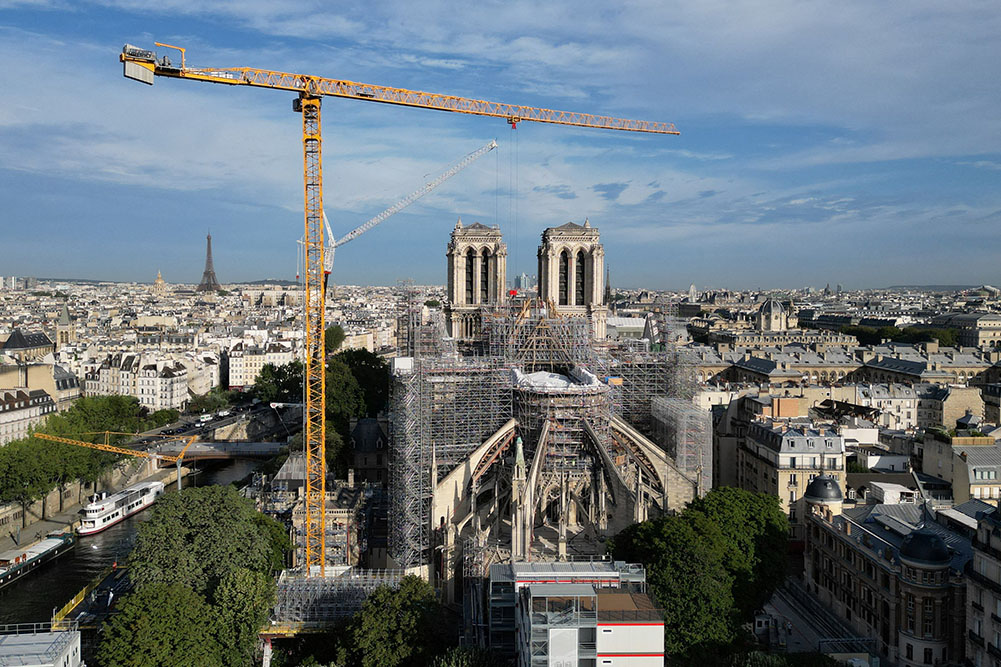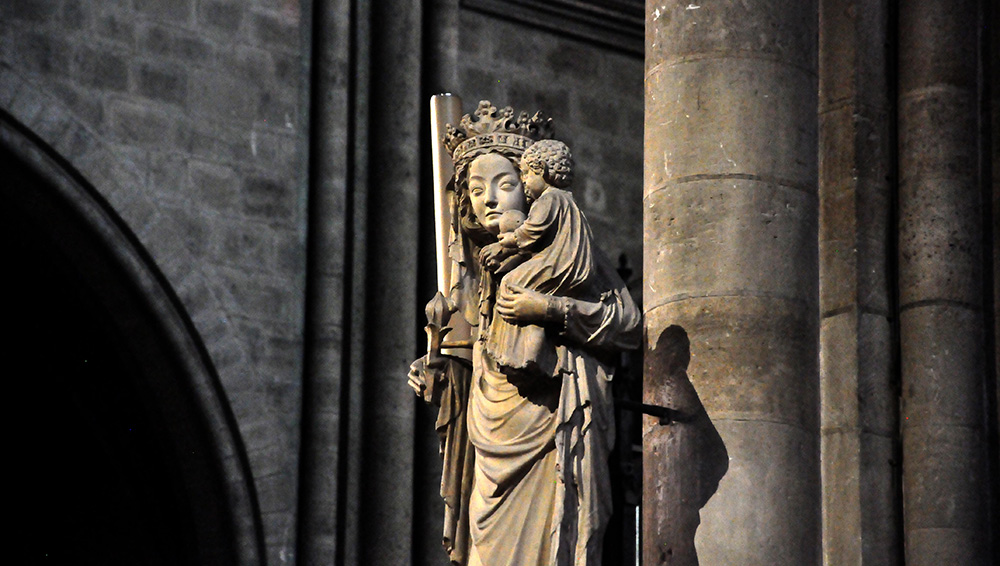
An aerial view shows the ongoing restoration work at Notre Dame Cathedral in Paris July 18. (OSV News/Reuters/Pascal Rossignol)
French President Emmanuel Macron said he would be inviting Pope Francis to attend the reopening of Paris' famed Notre Dame Cathedral. It will be a singular moment for Parisians and all French people, but also for millions of Christians worldwide. I hope the pope goes.
Many of us can recall that horrible April day in 2019 when fire engulfed the venerable cathedral. I remember getting a call from a friend to turn on the TV. All the cable networks had suspended their regular programming to watch as the fire grew and spread.
"As the flames leapt higher and higher, it seemed like a darkness was descending upon the spirit of all who have worshiped within the walls of the cathedral at the heart of Paris," I wrote at the time. "After the ancient roof had come crashing down to the floor, like a clap of evil thunder, silence and sorrow seemed the only thing anyone could manage."
It was like Tenebrae, the medieval liturgical monument that is celebrated on the evening before the Triduum.
Why did that tragic event so capture the imagination of the world?
Our powerful emotions of pain and loss when Notre Dame burned were the mirror image of the emotions of love and devotion for the Mother of God. Notre Dame was her cathedral.
Partly because we humans identify our sense of our humanity with specific places. We observe this in the liturgical calendar when we celebrate the feast of the Dedication of St. John Lateran on Nov. 9. We witness it in the tenacity with which people resist the closing of a much-loved parish, because we associate that space with the great events of our families' lives: baptism, first Communion, marriage and funerals. We hear it in the music of Anton Bruckner's astonishing motet "Locus iste," sung here by the Cathedral Choral Scholars of Salford Cathedral.
Partly because we felt that something not only beautiful but spiritually powerful was being destroyed. Through the centuries, the prayers of pilgrims had softened the stone arches and columns, imparting the sense of the sacred to the fabric of the structure that was palpable the moment you walked into the nave.
Partly, too, because this monument to the faith had lasted for so long, and our modern buildings, like so many of our modern ideas, are not built to last. We unconsciously worried that it might be impossible to recapture what the builders in the 12th and 13th centuries had captured, and that with the destruction of the building in which God had been worshiped for so long, the worship itself might be diminished.
Advertisement
If Notre Dame proved to be fragile, might not our faith be broken, too, amid the many destructive fires of our times?
Mostly, however, our powerful emotions of pain and loss when Notre Dame burned were the mirror image of the emotions of love and devotion for the Mother of God. Notre Dame was her cathedral. It was the cathedral of Paris and the Parisians only to the extent that it was first her cathedral, and on account of their centuries of turning to her in their need. Mary, hope of Christians. Mary, refuge of sinners. Mary, untier of knots. Mary, seat of wisdom. Mary, comfort of the afflicted.
When I visited Paris last February, I walked by the site and as I approached, I thought: This is the first time I have been in Paris and not gone to say a prayer in front of the statue of the Blessed Mother that stood to the right of the main altar. As I walked around the construction fencing to the square in front of the church, my heart leapt when I saw that they had placed that statue, which was not destroyed by the fire, on a column in the square.
I, we, everyone could still look upon her enigmatic expression and murmur the words, "Hail Mary, full of grace, the Lord is with thee."

The Virgin of the Pillar statue is seen inside Notre Dame Cathedral in Paris in 2018. (Wikimedia Commons/Bui Thanh Minh)
It is Advent, the quintessential Marian season. Yes, in the Scriptures, we think of Mary looking for the young Jesus in the Temple, at the wedding at Cana, or at the foot of the cross. But it is Mary's necessary participation in the birth of the savior that most captures our imagination.
"Blessed art thou among women, and blessed is the fruit of thy womb, Jesus." Our Catholic stubbornness about the sanctity of life is rooted not only in any ethical considerations, powerful though they be, but in those words, and in the fact that we celebrate the Annunciation on March 25.
Mary, pregnant with the Word of God, is the model of all Christians. We, too, are called to be pregnant with the Word of God, to bring that Word to birth in our lives and in our place and time.
Mary, at the Annunciation, delivers her fiat, "Let it be done to me," teaching us that the measure of our sanctity is the extent of our obedience to and cooperation with the Word of God.
"It is precisely with her daily fidelity in goodness that Our Lady allowed God's gift to grow within her. This is how she trained herself to respond to the Lord, to say 'yes' to him with her entire life," Pope Francis said during his Angelus address on the feast of the Immaculate Conception.
When Notre Dame burned, we wept because of our love for Mary. What graces might be waiting to be received when Notre Dame is reopened next year? What graces are available this week as, with Mary, we make our way to Bethlehem?







